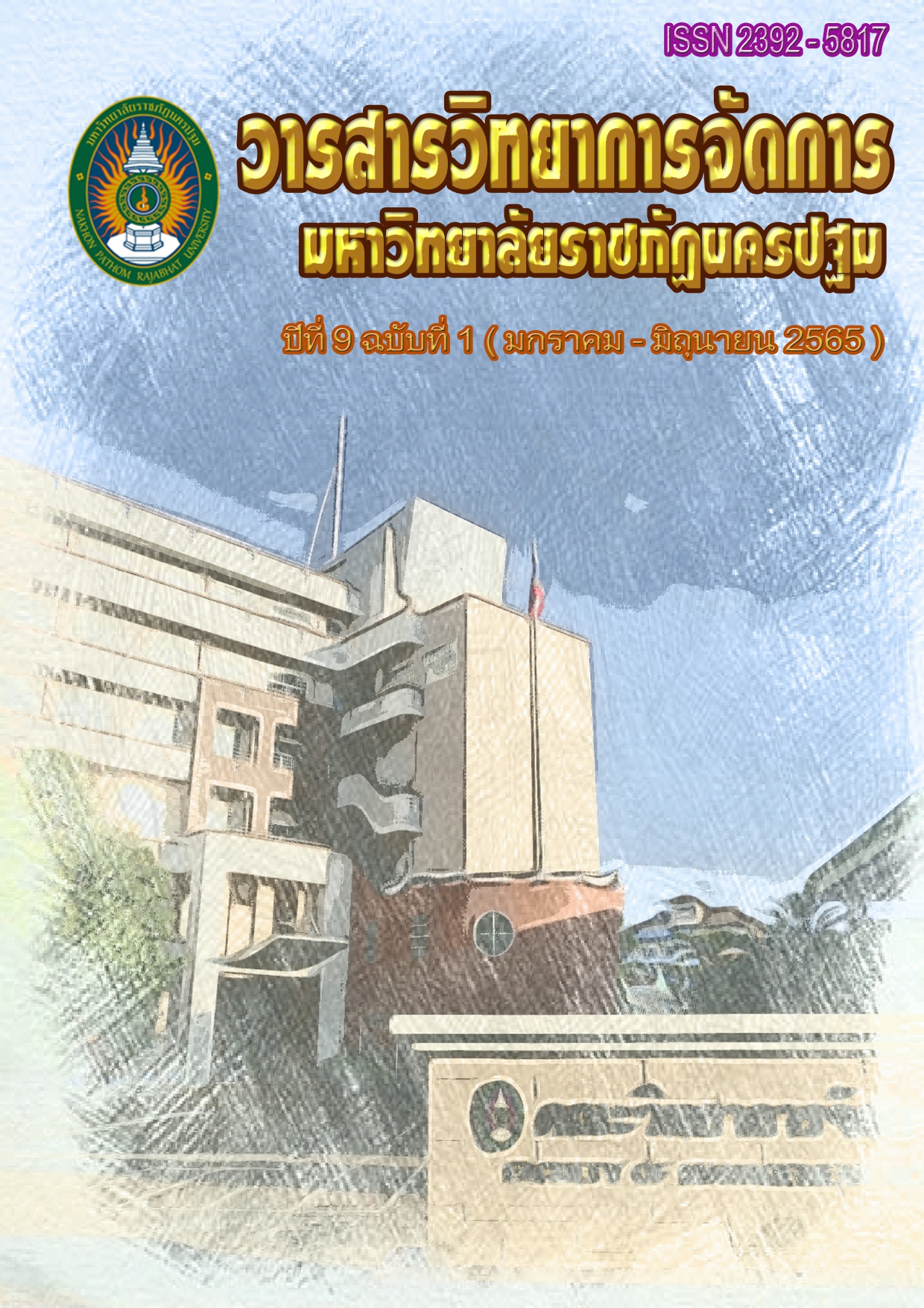การบูรณาการระหว่าง ผลิตภัณฑ์มวลรวมของประเทศ ความร่วมมือเพื่อการพัฒนา การลงทุนโดยตรงจากต่างประเทศ และการส่งออก: หลักฐานเชิงประจักษ์จาก สาธารณรัฐประชาธิปไตยประชาชน ลาว
Main Article Content
บทคัดย่อ
วัตถุประสงค์ของการศึกษาครั้งนี้ เพื่อทดสอบรูปแบบการเชื่อมโยงระยะสั้นและระยะยาวระหว่างผลิตภัณฑ์มวลรวมภายในประเทศที่แท้จริง (Ca) ความช่วยเหลือในการพัฒนาอย่างเป็นทางการจากประเทศ DAC ไปยัง สปป.ลาว (ODA) โดยพิจารณาจาก การลงทุนโดยตรงจากต่างประเทศ (FDI) และการส่งออก นักวิจัยใช้เทคนิคการวิเคราะห์ข้อมูลอนุกรมเวลาตั้งแต่ พ.ศ. 2531 ถึง พ.ศ. 2562 เก็บตัวอย่าง 32 รายการ จากธนาคารแห่ง สปป. ลาวและองค์การเพื่อความร่วมมือทางเศรษฐกิจและการพัฒนา (OECD) ร่วมกับการใช้เทคนิค แบบจำลองการแก้ไขข้อผิดพลาดของเวกเตอร์ ซึ่ง Ca เป็นสมการตัวแปรเป้าหมาย เนื่องจากสาเหตุระหว่าง ODA ยังคงเป็นปัญหาที่ถกเถียงกันอยู่ นอกจากนี้ นักวิจัยบางท่านแนะนำว่า ODA, FDI และ Ex จะมีผลกระทบต่อ GDP ในขณะที่บางท่านก็แนะนำว่า GDP ดึงดูด ODA, FDI และ Ex ดังนั้น การวิเคราะห์ในกรณีศึกษาของ สปป. ลาว มีเพื่อทดสอบความชัดเจนในการวิเคราะห์การรวมตัวระหว่างตัวบ่งชี้เหล่านั้น
ผลการวิเคราะห์เชิงประจักษ์ระบุว่าตัวแปรที่เสนอมีสาเหตุระยะยาวทั้งทางบวกและทางลบ ซึ่ง ODA และ FDI มีความสัมพันธ์เชิงบวก แสดงให้เห็นว่าหากปัจจัยดังกล่าวเพิ่มการไหลเข้าของ ODA และ FDI ก็จะทำให้ GDP ที่แท้จริงเพิ่มขึ้น ต่อหัว ในขณะที่ Ex มีความสัมพันธ์เชิงลบชี้ให้เห็นว่าการส่งออกที่เพิ่มขึ้นจะทำให้ GDP ต่อหัวที่แท้จริงลดลง ซึ่งขัดกับทฤษฎีทางเศรษฐศาสตร์ ผลที่เกิดขึ้นอาจจะเกิดจากจำนวนกลุ่มตัวอย่างที่ใช้ในการศึกษามีน้อยหรือการกระจายรายได้ไม่เท่าเทียมกัน ในแง่ของระยะสั้น ผลการวิจัยยังพบว่าไม่มีความสัมพันธ์เชิงสาเหตุแบบสองทิศทาง แต่มีความสัมพันธ์เชิงสาเหตุแบบทิศทางเดียวที่เรียกใช้จาก FDI ถึง Ca สาเหตุที่ทำงานจาก ODA และ Ex ถึง FDI และจาก ODA ไปยัง Ex ดังนั้นผู้กำหนดนโยบายควรส่งเสริมและดึงดูด FDI และ ODA ให้มากขึ้น เพื่อกระตุ้นการส่งออกและการเติบโตทางเศรษฐกิจ
*คณะเศรษฐศาสตร์ มหาวิทยาลัยยูนนาน ประเทศจีน 650106
Corresponding author: heping_econ@yahoo.com
Article Details

อนุญาตภายใต้เงื่อนไข Creative Commons Attribution-NonCommercial-NoDerivatives 4.0 International License.
ทัศนะและข้อคิดเห็นของบทความที่ปรากฏในวารสารฉบับนี้เป็นของผู้เขียนแต่ละท่าน ไม่ถือว่าเป็นทัศนะและความรับผิดชอบของกองบรรณาธิการ
เอกสารอ้างอิง
Andreas, G. and Anastasios,D. (2011). The causal links between FDI and economic development: Evidence from Greece. European Journal of Sciences, 27(1), 12-20
Baiashvili,T., and Gattini,L. (2019). Impact of FDI on economic growth: The role of country income levels and institutional strength. European Investment Bank, Working Paper 2020/02
Cipra, T. & Tlusty, P. (2008) . Estimation in multiple autoregressive -moving average model using periodicity. Journal of Time Series Analysis, 8, 293-301
Chakanyuka & Mashoko (2016). The relationship between FDI and ODA: The case of Zimbabwe (1980-2012), Retrieved July 28, 2020 ,from https://ir.uz.ac.zw/handle/10646/3186
Dickey, D. A., & Fuller, W. A. (1979). Distribution of the estimators for autoregressive time series with a unit root. Journal of the American Statistical Association, 74(366), 427-431.
Edmore & Nicholas (2019). Foreign aid, poverty and economic growth in developing countries: A dynamic panel data causality analysis. Cogent Economics & Finance, 7:1, DOI: 10.1080/23322039.2019.1626321
Engle & Granger (1987). Co-integration and error correction: Representation, estimation, and testing. Econometric, 55(2), 251–276.
Geetilaxmi, M., et al (2016). Foreign aid, macroeconomic policies and economic growth nexus in India: An ARDL bounds testing approach. Theoretical and Applied Economics, 4(69), 183-202.
Gounder, R. (2003). Causality analysis of development assistance and economic growth in Solomon Islands. Pacific Economic Bulletin .18 (1), 31-40.
Grossman & Helpman (1991). Innovation and growth in the global economy. Cambridge, MA: MIT Press.
Harrison & Hanson (1999). Who gains from trade reform? Some remaining puzzles. Journal of Development Economics, 59(1), 125-154.
Iamsiraroj, S., and Doucouliagos, H. (2015). Does growth attract FDI? E-Journal, Kiel Institute for the World Economy,9, 1-35
Jarque, C. M., & Bera, A. K. (1987). A test for normality of observations and regression residuals. International Statistical Review/Revue Internationale de Statistique, 55 (2).163-172.
Johansen, S. (1988). Statistical analysis of cointegration vectors. Journal of Economic Dynamics and Control, 12(2), 231–254.
Johansen, S. (1995). Likelihood-based inference in cointegrated vector autoregressive models. Oxford: Oxford University Press.
Kawthar, A and Karim, M. (2017). The Impact of foreign aid on economic growth in Morocco: Econometric analysis using VECM. International Journal of Economics and Finance 9(5), 87-93
Levine, & Roodman (2004). Aid, policies, and growth: comment. American Economic Review, 94(3), 774-780.
Minoiu & Reddy (2010). Development aid and economic growth: A positive long-run relation. The Quarterly Review of Economics and Finance, 50(1), 27-39.
Sahraoui, M.A., Belmokaddem,M., Guellil, M.S., and Ghouali, Y.Z. (2015). Causal interactions between FDI, and economic growth: Evidence from dynamic panel co-integration. Procedia Economics and Finance, 23(15), 276-290.
Sandrina, B.M. (2005). Evaluating the impact of foreign aid on economic growth: A cross-country study. Journal of Economic Development, 30(2), 25-48.
Sokang, K. (2018). The impact of foreign direct investment on the economic growth in Cambodia: Empirical evidence. International Journal of Innovation and Economic Development, 4(5), 31-38.
Song, S., and Zhang,X. (2017). Causality between foreign direct investment and economic growth for Cambodia. Cogent Economics & Finance, 5(1). https://doi.org/10.1080/23322039.2016.1277860
Zuzana, S. (2014). A causal relationship between foreign direct investment, economic growth and export for Slovakia. Procedia Economics and Finance, 15(14), 123-128.


